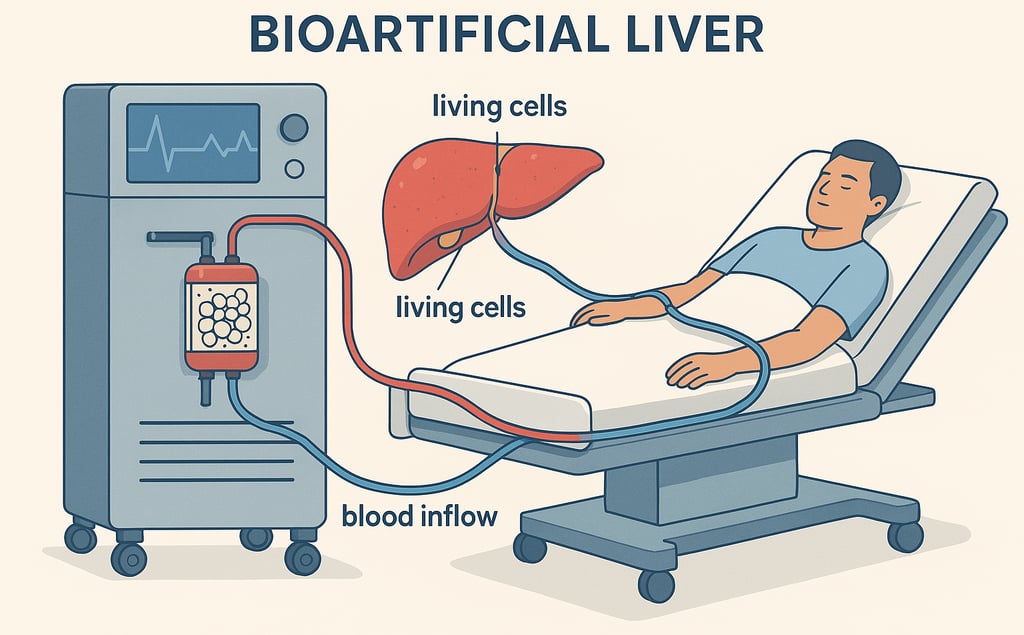Exploring Bioartificial Liver Devices: Innovations in Hepatic Support
In recent years, bioartificial liver devices have emerged as a groundbreaking development in the field of medical technology. These devices have the potential to revolutionize the treatment of liver diseases, providing vital support for patients suffering from acute liver failure or chronic liver conditions. In this blog, we’ll delve into what bioartificial liver devices are, how they work, and their potential impact on healthcare.
Medtechsolns
4/4/20252 min read


Understanding the Basics
A bioartificial liver (BAL) device is a hybrid system designed to perform several critical liver functions while patients await liver recovery or a transplant. The device combines biological components, typically liver cells or hepatocytes, with artificial materials to create a system that mimics the detoxification, metabolism, and synthesis processes of a healthy liver. By providing temporary support, BAL devices can significantly improve a patient’s chances of survival.
How Are They Built?
Biological Component: BAL devices use human or animal-derived liver cells. These cells are key to processing toxins, synthesizing proteins, and metabolizing substances in a way that artificial systems alone could not replicate.
Artificial Component: This includes a bioreactor chamber and filtration systems to facilitate the interaction between the patient’s blood and the liver cells. Advanced materials and technologies ensure that blood purity is maintained, and immune system reactions are minimized.
How Do They Work?
Patient blood is drawn and circulated through the bioartificial liver device.
Toxins and waste products are filtered, while vital substances like albumin are re-synthesized by the liver cells.
The "cleaned" blood is then returned to the patient’s body, providing critical liver support during a medical crisis.
Advantages of Bioartificial Liver Devices
The potential of BAL devices extends beyond mere scientific curiosity. Here are some key advantages:
Extended Survival Time: These devices provide a life-saving bridge to liver transplant or recovery, giving critical time to find a donor organ.
Reduction in Transplants: Some patients may recover liver function without requiring a full transplant, thanks to temporary BAL device support.
Customizable Solutions: Research is advancing rapidly, improving the scalability and customization of devices for individual patients.
Challenges to Overcome
Despite their promise, bioartificial liver devices face several challenges:
Cell Source: Obtaining a stable and ethical supply of hepatocytes remains a major hurdle.
Immune Response: Ensuring compatibility and avoiding immune rejection is a complex problem.
Cost and Accessibility: Developing BAL devices on a large scale while keeping them affordable for healthcare systems is a significant obstacle.
Future Outlook
With rapid advancements in biomedical engineering, the future of bioartificial liver devices looks promising. Researchers are exploring stem-cell-derived hepatocytes as a more sustainable and ethical option. Additionally, 3D bioprinting and microfluidic technologies are paving the way for more efficient and compact devices.
The widespread implementation of bioartificial liver devices could drastically enhance how we treat liver failure and reduce the reliance on organ transplants. While challenges remain, the continued commitment to innovation and research holds the potential to transform lives.
In conclusion, bioartificial liver devices represent a blend of ingenuity and hope in the fight against liver disease. As science and technology continue to intersect, the road ahead seems bright for these life-saving devices. Whether you’re a medical professional, a patient, or just a curious mind, the developments in this field are worth keeping an eye on for the future of healthcare. As we strive for these advancements, ethical considerations must also be addressed to navigate the complexities of bioartificial organs. Engaging stakeholders in dialogue will help pave the way for responsible innovation, fostering trust and acceptance among patients and healthcare providers alike. Looking to the horizon, the integration of bioartificial liver devices into clinical practice could mark a significant turning point in treatment options. Ongoing research, coupled with technological advancements, has the potential to transform patient outcomes and redefine the standard of care in hepatology.
